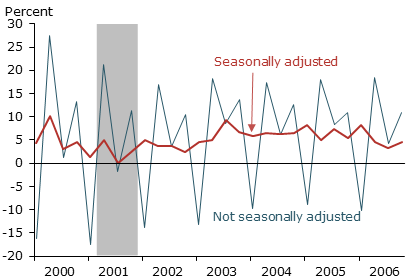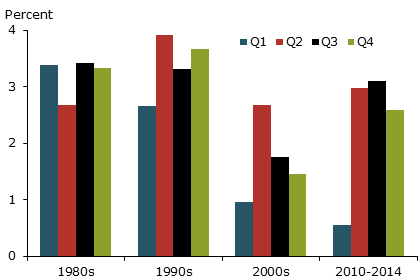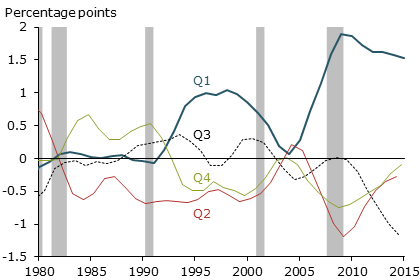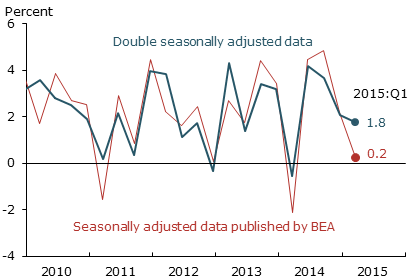The official estimate of real GDP growth for the first three months of 2015 was shockingly weak. However, such estimates in the past appear to have understated first-quarter growth fairly consistently, even though they are adjusted to try to account for seasonal patterns. Applying a second round of seasonal adjustment corrects this residual seasonality. After this correction, aggregate output grew much faster in the first quarter than reported.
In late April, the Bureau of Economic Analysis (BEA) released its initial estimate of U.S. economic growth for the first three months of 2015. The report was very disappointing, as inflation-adjusted, or real, gross domestic product (GDP) edged up a mere 0.2% at an annual rate in the first quarter. This estimate was far weaker than many economists had forecast, and it raised concerns that the underlying economic recovery may have stalled. Such anemic growth is of particular concern to Federal Reserve policymakers considering when to begin normalizing monetary policy.
However, a number of analysts have suggested that the reported weakness in first-quarter growth may have been exaggerated by a statistical anomaly (see, for example, Liesman 2015 and Wolfers 2015). Indeed, an unusual pattern has prevailed for some time in which first-quarter real GDP growth is generally lower than growth later in the year. This regular, calendar-based statistical pattern is a puzzle because the BEA seasonally adjusts the GDP data to remove such fluctuations. First-quarter seasonally adjusted real GDP growth should not be consistently higher or lower than growth in any other quarter. Accordingly, the anomalous pattern of generally weak first-quarter growth suggests that the BEA’s estimate of GDP growth for the first three months of 2015 may understate the true strength of the economy.
In this Economic Letter, we explore this residual seasonality puzzle by analyzing the seasonal pattern in the published real GDP data and by applying additional seasonal adjustment to those data. We find that a second round of seasonal adjustment implies that real GDP growth so far this year appears to have been substantially stronger than the BEA initially reported.
Why are economic data seasonally adjusted?
Almost all measures of economic activity exhibit strong seasonal fluctuations that occur at about the same time each year due to such things as normal weather variation and holiday schedules. For example, retail sales and household heating expenditures rise every winter, while residential construction falls. Similarly, at the aggregate level, spending and production have a strong seasonal pattern, as is evident in Figure 1. The figure compares nominal GDP growth that has not been seasonally adjusted with the BEA’s seasonally adjusted version. We use a nominal series here for illustration purposes only because the corresponding inflation-adjusted data are not available. On average from 2000 to 2006, nominal GDP before seasonal adjustment dropped about 10% at an annual rate every first quarter and rose about 20% every second quarter. Given these wild seasonal swings, it is difficult to detect the slowdown in growth that occurred during the 2001 recession, which is shaded in the figure. This difficulty illustrates the raison d’être of seasonal adjustment: It is intended to remove fluctuations in economic data that repeat at the same time and in the same fashion every year in order to reveal underlying cyclical and trend movements in the economy. Seasonally adjusted GDP estimates strip out recurring weather or holiday patterns that affect economic activity and make it much easier to observe that underlying nominal GDP growth fell several percentage points in the 2001 recession.
Figure 1
Quarterly nominal GDP growth at an annual rate

Source: BEA and Federal Reserve Board of Governors.
Residual seasonality in the GDP data
Seasonal fluctuations are not just extremely large; they also can vary in size over time. The BEA tackles the difficult challenge of seasonally adjusting GDP by starting with disaggregated raw data obtained from a variety of sources. Some of these source data have already been seasonally adjusted. The BEA may seasonally adjust the remaining individual series or judge that they do not require seasonal adjustment. Then, the BEA combines all of the underlying source data to produce the published aggregate GDP series. Unfortunately, as shown in Figure 2, an unusual seasonal pattern is evident in the BEA’s estimates of seasonally adjusted real GDP growth for the past 25 years. During the 1990s, real GDP growth averaged 2.6% at an annual rate in the first quarter and 3.6% in the subsequent three quarters. In the 2000s, growth also averaged 1 percentage point lower in the first quarter than during the rest of the year. From 2000 to 2014, this discrepancy increased, and the first-quarter growth shortfall jumped to 2.3 percentage points on average. Such leftover seasonal fluctuations in seasonally adjusted data are known as “residual seasonality.”
Figure 2
Average real GDP growth by quarter

Source: BEA; seasonally adjusted quarterly growth at annual rate.
The BEA (2015) acknowledges that its granular, bottom-up method of seasonal adjustment does not guarantee that the resulting aggregate series will be free of residual seasonality. For real GDP, the residual seasonality indicated by the persistently weak first-quarter growth rates in Figure 2 might reflect several factors. First, small seasonal patterns that were not significant in a variety of individual components may accumulate when added together to produce noticeable seasonal patterns in the aggregate GDP estimates. Second, some source data are seasonally adjusted at a monthly frequency; aggregating those to the quarterly GDP frequency may introduce seasonal patterns not evident in the monthly data. Finally, the nominal spending and production source data and the associated prices are often seasonally adjusted separately, but combining these series to produce the inflation-adjusted real GDP estimates may also result in residual seasonality. Therefore, the residual GDP seasonal variation appears to reflect the BEA’s granular, bottom-up seasonal adjustment procedure. Indeed, we found that all of the major components of GDP—consumption, business investment, net exports, government spending, and inventory investment—displayed some residual seasonality, which is consistent with a broad methodological source.
How strong was GDP growth in the first quarter?
The BEA uses a granular seasonal adjustment procedure in order to create a consistent set of disaggregated and aggregated National Income and Product Accounts data. However, certain users, including macroeconomic policymakers, may prefer instead to eliminate any residual seasonality in the aggregate GDP data in order to have the most accurate top-line measure of the broad economy.
To remove the residual seasonality in aggregate GDP, we applied a second seasonal adjustment to the BEA’s seasonally adjusted real GDP series. This second seasonal adjustment operates directly on data at an aggregate level and can be a useful supplement to the BEA’s bottom-up seasonal adjustment procedure that uses only disaggregated data. Our GDP series that is re-estimated with a “double” seasonal adjustment can be used to gauge how much first-quarter GDP growth has been affected by residual seasonality.
Specifically, we apply the same seasonal adjustment procedure that the BEA uses—the Census Bureau’s well-known X12-ARIMA statistical filter—to the aggregate real GDP data from the first quarter of 1960 through the first quarter of 2015. This technique provides different seasonal adjustment factors for each quarter that vary over time, as shown in Figure 3. If there were no residual seasonality in the published real GDP, then these seasonal factors would all be essentially zero, and our procedure would be innocuous. However, a statistical test rejects that hypothesis. Instead, the evidence indicates the presence of residual seasonality in the published data and supports our double seasonal adjustment procedure.
Figure 3
Changes to real GDP growth by quarter from a second seasonal adjustment

Source: Authors’ calculations.
Figure 3 shows the size of the second seasonal adjustment correction to GDP growth for each quarter. The correction pushes up published first-quarter real GDP growth by about 1 percentage point in the late 1990s and by about 1½ percentage points in the past several years. Conversely, during the past 25 years, real GDP growth in the second, third, and fourth quarters is somewhat lower after removing the residual seasonality.
Figure 4 shows recent real GDP growth—both the BEA’s published seasonally adjusted data in red and our double seasonally adjusted version in blue. The application of second-round seasonal adjustment increases real GDP growth in the first quarter of 2015 from its initial published value of 0.2% to 1.8%. Taking this correction at face value, real GDP growth in the first quarter was stronger and much closer to the economy’s sustainable rate of trend growth.
Figure 4
Quarterly GDP growth at an annual rate

Source: BEA and authors’ calculations.
Of course, seasonal adjustment is an imprecise and uncertain statistical exercise, and our results could overstate or understate the true amount of residual seasonality. Some closely related evidence is provided by conducting the same double seasonal adjustment on the BEA’s estimates of gross domestic income (GDI), which is an aggregate measure comparable to GDP. Using this alternative measure, we found very similar though slightly smaller second-round seasonal adjustment factors in recent years. Specifically, we estimate that residual seasonality will lower first-quarter GDI growth this year by about 1 percentage point. On the other hand, just a couple of years ago some economists warned that the BEA’s seasonal adjustment procedures would produce first-quarter GDP growth estimates that were inappropriately strong (see, for example, Kornfeld 2012 and Alexander and Greenberg 2012). They conjectured that the very sharp drop in GDP in the first quarter of 2009 during the Great Recession could lead to several years of residual seasonality that would push up published first-quarter GDP growth estimates. Similarly, the sequence of abnormally harsh winters during the past few years would tend to cause the seasonal adjustment factors to shift and start to predict further harsh weather; in this way, estimates of economic growth during a normal winter would be too strong after a standard seasonal adjustment. Our analysis suggests that if these influences are indeed at work, there are other even stronger seasonal factors pulling first-quarter growth lower.
Conclusion
The very weak initial estimate of first-quarter real GDP growth this year surprised many forecasters, in part because it was at odds with other fairly positive data, including solid employment gains over the past six months. We show that, although the BEA adjusts for seasonal movements at a disaggregated level, the published real GDP data still exhibit calendar-based fluctuations—that is, residual seasonality. After we apply a second round of seasonal adjustment directly to the published aggregate data, we estimate much faster real GDP growth in the first quarter of this year. We conclude that there is a good chance that underlying economic growth so far this year was substantially stronger than reported.
Glenn D. Rudebusch is director of research and executive vice president in the Economic Research Department of the Federal Reserve Bank of San Francisco.
Daniel J. Wilson is a research advisor in the Economic Research Department of the Federal Reserve Bank of San Francisco.
Tim Mahedy is an economic analyst in the Economic Research Department of the Federal Reserve Bank of San Francisco.
References
Alexander, Lewis, and Jeffrey Greenberg. 2012. “Echo of Financial Crisis Heard in Recent Jobless Claims Drop.” Special comment, Nomura Securities, February 23.
Bureau of Economic Analysis. 2015. “FAQ: How Does BEA Account for Seasonality in GDP?” April 23.
Kornfeld, Bob. 2012. “Seasonal Adjustment and BEA’s Estimates of GDP and GDI.” Presentation to the BEA Advisory Committee Meeting, May 11.
Liesman, Steve. 2015. “Why Is the Economy Always So Weak in the First Quarter? Nobody Really Knows.” CNBC, April 22.
Wolfers, Justin. 2015. “Why You Can’t Put Faith in Reports of First-Quarter Economic Slumps.” The New York Times, April 23.
Opinions expressed in FRBSF Economic Letter do not necessarily reflect the views of the management of the Federal Reserve Bank of San Francisco or of the Board of Governors of the Federal Reserve System. This publication is edited by Anita Todd and Karen Barnes. Permission to reprint portions of articles or whole articles must be obtained in writing. Please send editorial comments and requests for reprint permission to research.library@sf.frb.org